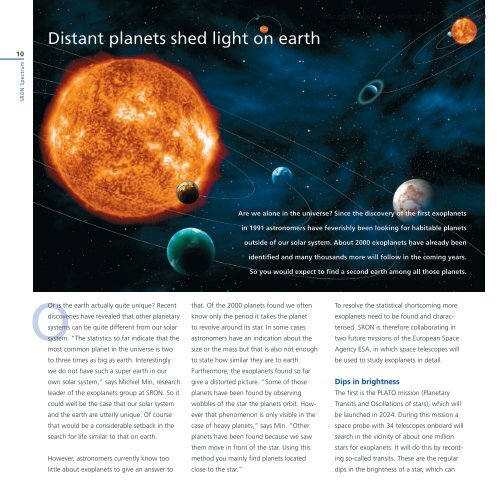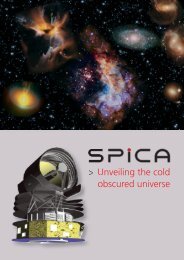SRON_Spectrum_2016
Create successful ePaper yourself
Turn your PDF publications into a flip-book with our unique Google optimized e-Paper software.
Artist impression van PLATO-missie (illustratie: ESA - C.Carreau).<br />
10<br />
Distant planets shed light on earth<br />
<strong>SRON</strong> <strong>Spectrum</strong><br />
Are we alone in the universe? Since the discovery of the first exoplanets<br />
in 1991 astronomers have feverishly been looking for habitable planets<br />
outside of our solar system. About 2000 exoplanets have already been<br />
identified and many thousands more will follow in the coming years.<br />
So you would expect to find a second earth among all those planets.<br />
Or is the earth actually quite unique? Recent<br />
discoveries have revealed that other planetary<br />
systems can be quite different from our solar<br />
system. “The statistics so far indicate that the<br />
most common planet in the universe is two<br />
to three times as big as earth. Interestingly<br />
we do not have such a super earth in our<br />
own solar system,” says Michiel Min, research<br />
leader of the exoplanets group at <strong>SRON</strong>. So it<br />
could well be the case that our solar system<br />
and the earth are utterly unique. Of course<br />
that would be a considerable setback in the<br />
search for life similar to that on earth.<br />
However, astronomers currently know too<br />
little about exoplanets to give an answer to<br />
that. Of the 2000 planets found we often<br />
know only the period it takes the planet<br />
to revolve around its star. In some cases<br />
astro nomers have an indication about the<br />
size or the mass but that is also not enough<br />
to state how similar they are to earth.<br />
Furthermore, the exoplanets found so far<br />
give a distorted picture. “Some of those<br />
planets have been found by observing<br />
wobbles of the star the planets orbit. However<br />
that phenomenon is only visible in the<br />
case of heavy planets,” says Min. “Other<br />
planets have been found because we saw<br />
them move in front of the star. Using this<br />
method you mainly find planets located<br />
close to the star.”<br />
To resolve the statistical shortcoming more<br />
exoplanets need to be found and character<br />
ised. <strong>SRON</strong> is therefore collaborating in<br />
two future missions of the European Space<br />
Agency ESA, in which space telescopes will<br />
be used to study exoplanets in detail.<br />
Dips in brightness<br />
The first is the PLATO mission (Planetary<br />
Transits and Oscillations of stars), which will<br />
be launched in 2024. During this mission a<br />
space probe with 34 telescopes onboard will<br />
search in the vicinity of about one million<br />
stars for exoplanets. It will do this by record -<br />
ing so-called transits. These are the regular<br />
dips in the brightness of a star, which can






